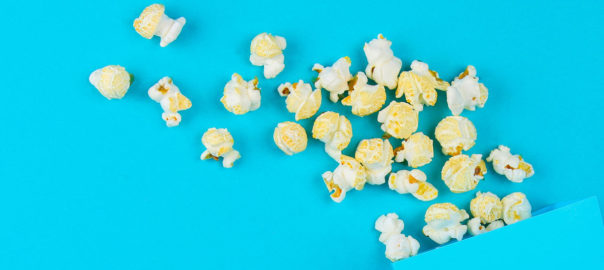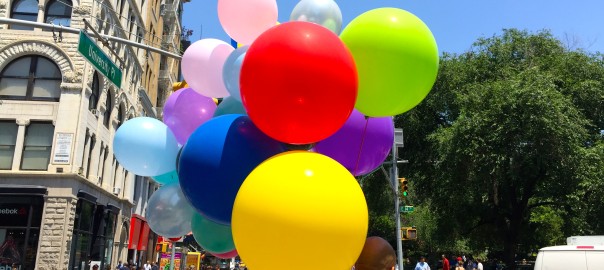|
|
|
|

|
|
|
|

|

“The micro-media app says it bought billboard space everywhere from Nice airport to the Palais.”
“We’re trying to move away from Facebook as fast as we can.”
“Around 11 percent of internet users were running an ad blocker.”
“If you ‘follow the money,’ Auletta writes, you’ll understand the importance of advertising and the significance of the threats against it, and maybe value it more, or at least disdain it less.” High praise indeed!
“Facebook allowed housing advertisers to block users from seeing their ads if those users had a black, Latino or Asian-American ‘affinity.’”

5 REASONS FOR OPTIMISM
About the book business, from Marcus Dohle.
WALL STREET JOURNAL SEEKS WOMEN
New ad campaign targets ambitious GenZers and Millennials, especially women. “Those generations have a huge desire to make stuff happen.”
WHERE DO I CLICK?
Instagram changes its CTA palette to reflect dominant color of the content. A good idea?
BILLBOARDS THAT TELL A STORY
That is, they really have a lot of text. Not for drivers, obviously. Could be great for excerpts though, and reasonably priced.

The Wall Street Journal reports on how the millennial news platform .Mic is rethinking video sponsorship. Mic is allowing advertisers to sponsor their highly popular videos on Facebook:
“Instead of selling…ads based on content genre or audience demographics, Mic is putting its editorial videos into categories, such as clips that elicit emotions or videos that celebrate innovation—two popular genres that typically incite people to share, and letting advertisers run ads next to these types of videos.”
While this kind of sponsorship is not useful for any book that needs time to tell its story, it could be very interesting for a book with immediate appeal to millennials with a high education and relatively high HHI.
Have you played around with Google’s Display Ad benchmark tool recently? It can be very useful for setting expectations. Click-through rates seem to be going down across the board. If you set it for U.S. Book ads, the display CTRs range from .04-.6% depending on the size. Mobile only sizes such as 320×50 fare a little better with a .18% CTR. While this is certainly the case for the industry as a whole, Verso’s own click-through rates continue to beat industry averages—ranging from about .10% for desktop to twice that for mobile.
#CTR #Google #data #benchmarks
Long a staple of advertising plans for all manner of products, out-of-home advertising has gained a new edge with digital billboards. Digital capabilities mean advertisers can move much more quickly on campaigns instead of having to plan six to eight months ahead for each iteration. As CMO magazine puts it:
“The integration of data and technology means advertisers can tap into OOH like never before. ‘And it’s really shifting into bringing back the things that digital has kind of lost–the sensory experiences, feelings, and interactions.'”
There’s a reason spending on out of home advertising continues to grow.
#billboards #OOH #digital
As part of IAB’s recent podcast upfronts, ESPN announced that it’s bringing it’s acclaimed 30 for 30 series to podcasts. With in-depth reporting about sports news, 30 for 30 videos appeal to sports fans of a more thoughtful bent . . . which is to say, sports fans who might be inclined to buy books on a subject in an effort to go deeper than in-game color commentary or talk show style chatter. For book publishers who might not be able to afford a :30 ad on ESPN, running mid-roll on a podcast might be a highly targeted ad solution.

Podcasts don’t provide traditional reporting for ads, but a recent study suggests that it does sell products (well, underwear anyway). Mack Weldon reports that doubling-down on humorous podcasts has doubled their sales. According to Digiday:
“Podcast advertising now represents 25 percent of Mack Weldon’s overall ad budget per month, 100 times more than a year ago. The medium has become more effective than display ads for the company, because when people listen to podcasts, they are fully engaged and they can continue listening while making a purchase.”
Huffington Post has found that “feel-good” videos far out-perform hard news stories on Facebook. Of course, this tells you more about what the Huffington Post audience is looking for than other audiences. But it’s worth keeping in mind.
The hot social platform that’s about as digital and evanescent as they come recognizes the power of an old-school, well-placed billboard in real space. A new Snapchat billboard campaign manages to go both mass and hyper-local at the same time. Well played.
The music streaming service is popular with listeners but has under-performed Pandora for Verso clients. We’re glad to see they’re paying more attention to their mobile ad product, and look forward to trying it out:
“Starting today, the music streaming service is bringing Billboard—one of its most popular desktop ad formats—to mobile. The feature, dubbed Overlay Mobile, lets advertisers buy display ads for both iOS and Android mobile devices. It serves as the “Welcome Back” ad, and only plays when a user has the screen open, which Spotify says provides 100 percent viewability.”
In a new Instagram-commissioned study (worth noting, not neutral), Nielsen found that Instagram was the buzziest social network for the most avid music fans:
“According to a new Instagram-commissioned study by Nielsen of more than 3,000 self-described Instagram users, the photo- and video-sharing platform is the most-used social network for music fans, festival attendees and artists during live events. The study also provides insight into what fans like, listen to and buy.”
Worth thinking about for the next music book.
Ad Age reports on the new tap-to-vote app, Wishbone, that’s proving a hit with teens, and inspiring creative engagement from brands who want to reach them–in both content and paid advertising plays.
Salesforce CEO Scott McCorkle makes the case for “layered marketing”—marketing across different platforms and media, playing to each one’s strength—with an essay in Ad Age that points out how the wonders of the next big thing do not necessarily mean the death of what came before.

In an article about how Google’s new AMP system works, AdAge connects to very clear graphics that show clearly how the complexity of ad exchanges and analytics tracking slows down load times—and how AMP fixes that.
“When compared to traditional mobile websites, AMP pages load 85% faster, Google says.
‘The New York Times itself is running very fast,’ Ghostery CEO and founder Scott Meyer said regarding the desktop version of the site. ‘But once you get beyond the Times, and into the far reaches of the ad exchanges, a lot of those companies are going to be slow to load and there will be an impact on user experience.’
AMP is a response to similar but proprietary platforms like Facebook Instant Articles and Apple News. Unlike those, however, AMP is open source, meaning anyone can use it.”
It’s worth a click through to see the dynamic images, but here is a screenshot of the desktop ecosystem for a NYTimes.com story:
Here’s a shot of the mobile ecosystem:
And here’s a shot of the new AMP ecosystem for the same story:
AdAge has a fascinating article about the latest big brand thinking around mobile advertising. Long story short: It’s not about the campaign.
“The perfect mobile campaign isn’t a campaign,” said Carl Norberg, founder and chief experience officer of mobile-focused shop Monterosa/BBH Stockholm, which has created initiatives for clients such as Volvo, Justin Bieber, Google, Axe and others. “It’s a brand extension where marketing comes baked into the product.” While great TV is storytelling, great mobile is about “storydoing,” he said. “Instead of us telling the story, we hand over an app to let the consumer become an active part of the brand’s tale.”
While the takeaways for book publishing’s fleet of individual, smaller scale products is not great; it’s important to remember that “mobile” isn’t a platform any more. It’s how most people scan email, check Facebook, Tweet, research restaurants, and even (in some cases) read books.
The New Yorker has an interesting article on the “For your consideration” billboards that use a mass medium to reach a very targeted audience. Why do they use a mass medium when the target is so specific? Because they work in a couple different ways:
Kirsten Oliphant has a good piece up on Jane Friedman’s blog about best practices for authors on Pinterest. It’s an especially good platform for lifestyle and cooking, and worth a read.
Foursquare announces that it can connect digital ads seen by Foursquare users with foot traffic in stores. Testing has already begun:
“Flipboard recently used the system to measure a campaign that it ran for an undisclosed retailer and found that the digital ads drove a 12 percent incremental lift in visits to the retailer’s locations within a week.”
Connecting the digital ad space to real world traffic is vital to understanding how our ads work with the people who see them. It will be exciting to see how this new product develops. In a followup article, Adweek mentions other players in this space. The interest in this is only growing.
Marketers and party planners alike will be happy to hear of Snapchat’s new rollout of make-your-own geofilters for the platform.
Dominos has run some successful experiments in marketing on the channel that marketers are scrambling to figure out to reach the post-Millennial generations
It’s not just show-rooming: a study from Google on in-store mobile use has a few key takeaways:
eMarketer notes that, at this pace, more than a third of internet users will be on Instagram by 2017. The article includes projections for Facebook, Twitter, Pinterest, and Tumblr too.
There are 198 million ad block users worldwide. This infographic on Hubspot goes into detail about who are leading the charge, heavy into tech, gaming, sports and social. Not surprisingly it’s the young male demo. The older female demographic (core, avid readers) are the least likely to be using an ad blocker.
eMarketer talks to Digitas LBI Social Director about the pros and cons of podcasts for marketers.
ClickZ attended Twitter’s Flight Camp so you don’t have to. Good stuff here for social media managers.
#twitter #social #bestpractices
A week travelling on the West coast with a pair of 15 year-old boys has shown me the vitality of Snapchat, the generational divide (and I mean the one that the millennials are starting to feel with the generation after them . . . ), and how Gen X just. doesn’t. get. it.
More evidence that the digitally connected older generation are where the action is with digital marketing.
Integration with Giphy and Riffsy make it easier for Twitter users to post animated gifs.
Why haven’t buy buttons on FB and Instagram taken off yet? Because they’re trying to force top of the funnel marketing down the funnel too far…. Customers aren’t interested in that (need a little more time and comfort before making the purchase).
#facebook #instagram #thefunnel
It’s still a great way to reach the YA audience, but Tumblr’s growth is slowing. Here are projections via eMarketer:
“Regarding its total user base, this will be the last year Tumblr will grow by double digits, signaling a plateau. In 2016, Tumblr will have 23.2 million users in the US. That’s less than half as many as Pinterest (which has 54.6 million) and less than a third as many as Instagram (which has 89.4 million).”
The image at the top of this post is taken from the current Tara Donovan show at the Quint Gallery.
![]() .com — Do you know about the “Home Page Advantage Pop-Up Menu”? It delivers over 30,000,000 impressions for a very low $1 CPM, and it’s a great place to advertise well-known brands. Our clients who publish a popular diet book loved it so much that they doubled the length of their campaign after first-wave results came in.
.com — Do you know about the “Home Page Advantage Pop-Up Menu”? It delivers over 30,000,000 impressions for a very low $1 CPM, and it’s a great place to advertise well-known brands. Our clients who publish a popular diet book loved it so much that they doubled the length of their campaign after first-wave results came in.
![]() – Consistently a great place for books. It can nicely complement a television campaign and is extremely targeted. We have run many campaigns for everything from vampire books to children’s books, with great success.
– Consistently a great place for books. It can nicely complement a television campaign and is extremely targeted. We have run many campaigns for everything from vampire books to children’s books, with great success.
![]() — These general news sites are not only a good place to reach a broad audience for a relatively inexpensive CPM, but they also do a great job of increasing awareness about books in many bestselling genres, from business to fiction.
— These general news sites are not only a good place to reach a broad audience for a relatively inexpensive CPM, but they also do a great job of increasing awareness about books in many bestselling genres, from business to fiction.
Phone Kiosks / Billboards — Phone kiosks continue to be an affordable way to advertise books. We can target by city and even by neighborhood, and kiosks start for as little as $250 each. We’ve recently secured some great deals on billboards in NY and LA—on Sunset Blvd in LA, and Times Square for as little as $40,000 for 4 weeks.